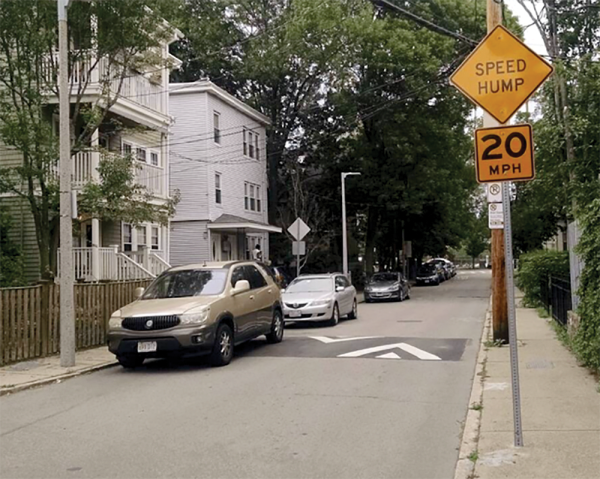May 24, 2023

A road hump on a Boston street. City of Boston photo
Slowing down traffic in Dorchester and Mattapan can at times seem like a game of Whack-a-Mole: Introduce measures in one section to discourage speeders, and they pop up racing along streets a few blocks away.
If Mayor Wu and her advisers get their way, a $12 million ‘Safety Surge’ will change that dynamic. The mayor visited Dorchester’s Thetford/Evans Playground on Monday to announce a three-year plan to install speed humps on hundreds of streets across the city that represents a significant increase over the number of streets that have been part of the city’s Slow Streets program, an effort limited in scope and subject to a competitive application process.
Now, Wu says, speed humps will be installed on all eligible neighborhood streets in zones as determined by crash data and other key indicators.
“It shouldn’t just be these three streets Thetford, Stanton and Evans Street around this park with speed humps,” she said on Monday. “What I hear from neighbors throughout the city is that when they bought their home, they did so because they had a front yard for their kids to play in …and they anticipated aging in place and community.
Mattapan’s Fatima Ali Salaam, left, and Barbara Crichlow, second from left, talk with Mayor Wu and city Chief of Streets Jascha Franklin-Hodge about how speed humps have improved the areas around the Dorchester-Mattapan line by Thetford/Evans Playground. Seth Daniel photo
“As more and more speeding cars race through our side streets, even front yards off the street are not completely safe for families and adults. We’ve had situations in Boston as recent as this past week when someone sitting on their porch has had cars jump the curb and go into their front yard.”
Wu added that congestion on major roadways shouldn’t push people to drive fast and recklessly or drive in the wrong direction on side streets “because traffic apps push cars there and suddenly you have the new American Legion Highway.”
Jascha Franklin-Hodge, who serves as the city’s chief of streets, is heading up the effort, which also includes annually redesigning intersections for safety, implementing new guidelines for the city’s traffic signals, and adding more ‘No Turn on Red’ signs.
He said that he gets messages from the Boston Police nearly every week about a traffic crash involving a vehicle and a pedestrian or a cyclist, and at times those messages include notification of the Fatal Reconstruction Crash Team. There were 12 pedestrian deaths last year in Boston, he noted.
“I hear the frustration of people saying they are tired of worrying about their kids or their parents,” Franklin-Hodge said. “Parents are worried their kids are not safe riding their bike on the route to school.”
Roughly 394 of the city’s 800 miles of roadways have been deemed eligible for speed humps. Streets not eligible include major thoroughfares like Dorchester and Talbot avenues or any street that has an MBTA bus route.
The city has already identified several zones across each neighborhood and is committed to building out 10 of them per year over the next three years. Speed humps will be incorporated into the routine design for all eligible streets, meaning that when a street is re-paved, it will include building out speed humps. The decisions as to which zones come first will be based on crash data and demographic information for the neighborhood.
Already several neighborhoods in Dorchester have benefited from speed humps as part of the Slow Streets program, including the Talbot-Norfolk-Triangle (TNT), West of Washington (WOW), the streets around Thetford/Evans Playground where Monday’s press conference took place, not to leave out the major measures taken last year on Milton Avenue.
Barbara Crichlow, of nearby West Selden Street, said that from her view, the program has been effective. “The people on this street and other nearby areas, they all want speed humps. All these homes here, these three-deckers, they all have children. When people come off a main road and cut through the neighborhood, they interrupt where children live and play. They need to slow down traffic.”
The earlier Slow Streets program has been thought of as a pilot to see if communities liked speed humps and if snowplows could navigate them. When it proved to be a success, everyone wanted them and getting them became a problematic competition.
“The old Slow Streets program pitted one community against the next,” said state Rep. Russell Holmes. “You had to show you were the worst and had the most crashes and most deaths and then you get speed humps. That is an inappropriate process because you had to prove you were the worst.”
Added City Councillor Brian Worrell: “We’re happy the new process is more transparent and fairer and doesn’t pit one neighborhood against the other.”
On the city’s new “humps” map, many streets are labelled as “Eligible for Future Phases.” Itasca Street in Mattapan, which has been working on getting speed humps for a few years now, is on that list.
Meanwhile, Seaver Street (from Blue Hill Avenue south), Erie Street, Ellington Street, and the Glenway corridor are now listed on the docket as getting speed humps between 2024 and 2026. In Bowdoin-Geneva, speed humps are coming soon and labelled as ‘In Progress’ on the “humps” map. Streets such as Homes Avenue, Speedwell Street, Olney Street, and Hamilton Street will be getting speed humps installed soon.
Franklin-Hodge said the city is still weighing measures to curb scooters and dirt bikes, which are a particular nuisance and public safety concern in warmer months. Scooter riders often avoid calming measures by travelling on sidewalks.


